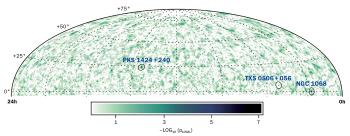
Based on just four weeks of running, researchers at the Karlsruhe Tritium Neutrino (KATRIN) experiment in Germany have set a new model-independent bound on the mass of the neutrino. At a colloquium today, the collaboration reported an upper limit of 1.1 eV at 90% confidence, almost halving the previous bound.
Neutrinos are among the least well understood particles in the Standard Model. Their three known mass eigenstates do not match up with the better-known flavour eigenstates, but mix according to the PMNS matrix, resulting in the flavour transmutations seen by neutrino-oscillation experiments. Despite their success in constraining neutrino mixing, such experiments are sensitive only to squared mass differences between the eigenstates, and not to the neutrino masses themselves.
Physicists have pursued direct mass measurements since Reines and Cowan observed electron antineutrinos in inverse beta decays in 1956. The direct mass measurement method hinges on precisely measuring the energy spectrum of beta-decay electrons, and is considered model independent as the extracted neutrino mass depends only on the kinematics of the decay. KATRIN is now the most precise experiment of this kind. It builds on the invention of gaseous molecular tritium sources and spectrometers based on the principle of magnetic adiabatic collimation with electrostatic filtering. The combination of these methods culminated in the previous best limits of 2.3 eV at 95% confidence in 2005, and 2.05 eV at 95% confidence in 2011, by physicists working in Mainz, Germany and Troitsk, Russia, respectively. The KATRIN analysis improves on these experimental results, with systematic uncertainties reduced by a factor of six and statistical uncertainties reduced by a factor of two.
These are exciting times for the collaboration
Guido Drexlin
“These are exciting times for the collaboration,” said KATRIN co-spokesperson Guido Drexlin. “The first KATRIN result is based on a measurement campaign of only four weeks at reduced source activity, equivalent to five days at nominal activity.” To reach its final sensitivity, KATRIN will collect data for 1000 days, and systematic errors will be reduced. “This will allow us to probe neutrino masses down to 0.2 eV,” continued Drexlin, “as well as many other interesting searches for beyond-the-Standard-Model physics, such as for admixtures of sterile neutrinos from the eV up to the keV scale.”

Conceived almost two decades ago, KATRIN operates using a high-resolution, large-acceptance and low-background measurement of the decay spectrum of tritium 3H → 3He e– ν̄e. Electrons are transported to the spectrometer via a beamline that was completed in autumn 2016, allowing experimenters to search for distortions in the tail of the electron energy distribution that depend on the absolute mass of the neutrino. KATRIN collaborators are now looking forward to a two-month measurement campaign, which will start in a few days. It will feature a signal-to-background ratio that is expected to be about one order of magnitude better than the initial measurements, due to an increase in source activity, and a decrease in background due to hardware upgrades. The goal is to achieve an activity of 1011 beta-decay electrons per second, while reducing the current background level by about a factor of two.
Direct measurements are not the only handle on neutrino masses available to physicists, though they are certainly the most model independent. Experiments searching for neutrinoless double beta-decay offer a complementary limit, but must assume that the neutrino is a Majorana fermion.
The tightest limit on neutrino masses comes from cosmology. Comparing data from the Planck satellite with simulations of the development of structure in the early universe yields an upper limit on the sum of all three neutrino masses of 0.17 eV at 95% confidence.
The Planck limit is fairly robust, and one would have to go to great lengths to avoid it
Joachim Kopp
“The Planck limit is fairly robust, and one would have to go to great lengths to avoid it – but it’s not impossible to do so,” says CERN theorist Joachim Kopp. For example, it would be invalidated by a scenario where as-yet-undiscovered right-handed neutrinos couple to a new scalar field with a vacuum expectation value that evolves over cosmological timescales. “Planck data tell us what neutrinos were like in the early universe,” says Kopp. “The value of KATRIN lies in testing neutrinos now.”







